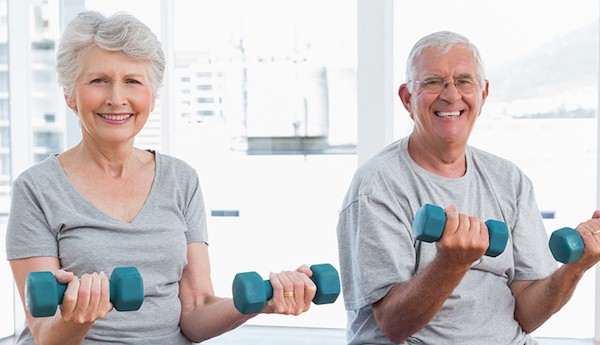This one is for the oldies out there! Just a few minutes of low intensity exercise can help you lower your death risk!
Posted on March 19th, 2018 by Andries Lodder
The importance of exercises for older adults
How physically active are you? Some might answer “I am to busy to fit in a exercise session”. Others might say that “I am to old to do exercises”. The recommended guidelines for exercise for older adults are at least 150 minutes a week of moderate to vigorous physical activity. For some older people this is just not possible. Don’t worry current research by the St George’s University of London showed that a few minutes of physical activity (at any level), to a total of 150 minutes a week, correlates to a lower risk of death in older men. The researchers further suggested that the 150 minutes can be divided into 10 minutes bouts of low intensity exercises. (Jefferis, Parsons, Sartini, Ash, Lennon, Papacosta & Whincup, 2018)
It is important to remember that regular physical activity plays an vital role in healthy aging and chronic disease management. Here are a few guidelines to follow when you are planning to start a new exercise program.
- Your exercise planning should keep your health status and functional capacity in mind.
- Set realistic goals that is achievable.
- Planning is key, when planning to exercise keep the type, frequency and intensity of the exercise in mind (It is suggested that you start of slowly and gradually increase the intensity, frequency and time as you progress)
Older adults will derive distinct benefits from the following exercises:
Prof Jerome Flog (a researcher from the division of Cardiovascular Sciences, National Heart, Lung, and Blood Institute, National Institutes of Health) says that the key to successful aging is aerobic exercises. Aerobic exercises have a beneficial effect blood pressure, lipids, glucose tolerance, bone density, depression and quality of life. You can read more about his research by following this link: Aerobic Exercise in the Elderly: A key to successful aging.
Strength training in older adults can help reduce arthritis (reduces pain and stiffness, and increases strength and flexibility), diabetes (improves glycaemic control), osteoporosis (builds bone density and reduces risk for falls), heart disease (reduces cardiovascular risk by improving lipid profile and overall fitness), obesity (increases metabolism, which helps burn more calories and helps with long-term weight control) and back pain (strengthens back and abdominal muscles to reduce stress on the spine). Experts at the Center for Disease Control and Prevention and Tufts University, with the help of older adults, have created this book, Growing Stronger: Strength Training for Older Adults to help you become stronger and maintain your health and independence. You can download your online copy by following this link: Growing Stronger – Strength Training for Older Adults.
Stretching is important as you get older. The benefits of stretching includes; development and maintenance of strength, improving flexibility, and increased circulation and blood flow, to provide a greater quality of life and healthy. Stretching reduces lower back pain and arthritis, reduces your risk of falling, helps improve your posture and increases your energy levels. It is recommended that you stretch at least once per day.
Balance should not be taken for granted. It is important to navigate without the fear or effort. Balance is probably one of the most important aspects in life to focus on as it effects your confidence to complete any tasks in daily living. For some people balance is a problem. Exercise can reduce your chances of suffering a fall-related injury. In a study conducted on older adults and the effect of fall prevention exercise programs it was indicated that exercise programs reduced falls that caused injuries by 37%, falls leading to serious injuries by 43% and broken bones by 61%. This report was published online in the BMJ – If you would like to read the full article please follow this link: The Effects of Fall Prevention Exercises.
If you want to test your balance and co-ordination please feel free to contact our practice and we can do scientific testing to formulate an exercise program specifically for your need that can help diminish your risk of falling.
References:
Jefferis, B. J., Parsons, T. J., Sartini, C., Ash, S., Lennon, L. T., Papacosta, O., … & Whincup, P. H. (2018). Objectively measured physical activity, sedentary behaviour and all-cause mortality in older men: does volume of activity matter more than pattern of accumulation? Br J Sports Med, bjsports-2017.
Fleg, J. L. (2012). Aerobic exercise in the elderly: a key to successful aging. Discovery medicine, 13(70), 223-228.
Tweet
